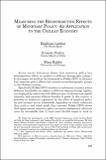Mostrar el registro sencillo del ítem
Measuring the redistributive effects of monetary policy: an application to the chilean economy
| dc.contributor.author | Luttini, Emiliano | |
| dc.contributor.author | Pastén, Ernesto | |
| dc.contributor.author | Rubbo, Elisa | |
| dc.date.accessioned | 2024-12-05T16:13:30Z | |
| dc.date.available | 2024-12-05T16:13:30Z | |
| dc.date.issued | 2024 | |
| dc.identifier.isbn | 9789567421749 | |
| dc.identifier.isbn | 9789567421732 (digital) | |
| dc.identifier.issn | 0717-6686 (Series on Central Banking, Analysis, and Economic Policies) | |
| dc.identifier.uri | https://hdl.handle.net/20.500.12580/8021 | |
| dc.description | Active recent literature shows that monetary policy has heterogeneous effects on workers in different demographic groups.1 In this paper, we build on the framework in Rubbo (2023) to estimate how monetary policy affects real incomes across demographic groups in the Chilean economy. Specifically, Rubbo (2023) considers a multisector economy where different households are subject to different degrees of wage rigidity, are employed by industries with different price stickiness and capital intensity, and consume different bundles of goods. In this context, it provides an analytical expression for the effect of monetary policy on real incomes across households, depending on which industries they work in and which goods they consume. | es |
| dc.description.abstract | Active recent literature shows that monetary policy has heterogeneous effects on workers in different demographic groups.1 In this paper, we build on the framework in Rubbo (2023) to estimate how monetary policy affects real incomes across demographic groups in the Chilean economy. Specifically, Rubbo (2023) considers a multisector economy where different households are subject to different degrees of wage rigidity, are employed by industries with different price stickiness and capital intensity, and consume different bundles of goods. In this context, it provides an analytical expression for the effect of monetary policy on real incomes across households, depending on which industries they work in and which goods they consume. | es |
| dc.format | ||
| dc.format.extent | Sección o Parte de un Documento | |
| dc.format.medium | p. 109-134 | |
| dc.language.iso | en | es |
| dc.publisher | Banco Central de Chile | es |
| dc.relation.ispartofseries | Series on Central Banking Analysis and Economic Policies; no. 30 | |
| dc.rights | Attribution-NonCommercial-NoDerivs 3.0 Chile | * |
| dc.rights.uri | http://creativecommons.org/licenses/by-nc-nd/3.0/cl/ | * |
| dc.subject | POLÍTICA MONETARIA | es |
| dc.subject | ECONOMÍA - CHILE | es |
| dc.title | Measuring the redistributive effects of monetary policy: an application to the chilean economy | es |
| dc.type.doc | Artículo |


